April 24, 2023 – Due to melting snowpack from near-record levels entering the Colorado River system, Lake Mead is expected to receive a much-needed influx of water this summer.
After a decline of over 50 feet since 2020, it is now predicted that Lake Mead’s water level will rise by approximately 22 feet by the end of the year, based on recent forecasts from the Bureau of Reclamation. At present, Lake Mead is filled to approximately 29% of its total capacity.
The abundant winter snowpack and expected runoff will enable the Bureau to release an additional 2.5 million acre-feet of water from Lake Powell to Lake Mead during the current water year. The water year spans from October 1 to September 30. The extra water released will increase Lake Mead’s elevation to around 1,068 feet by December. If these predictions prove accurate, it would be only the fourth time since 2000 that the reservoir, located east of Las Vegas, finishes the year with a higher water level than it began with.
during the current water year. The water year spans from October 1 to September 30. The extra water released will increase Lake Mead’s elevation to around 1,068 feet by December. If these predictions prove accurate, it would be only the fourth time since 2000 that the reservoir, located east of Las Vegas, finishes the year with a higher water level than it began with.
To support the reservoir, the Bureau of Reclamation had intended to limit Lake Powell’s releases to 7 million acre-feet this year. The decision was based in part on the fact that Lake Powell’s water levels had dropped below 25% capacity in recent years, causing concerns about Glen Canyon Dam’s ability to generate hydropower. However, due to this year’s heavy winter snowpack in the Upper Colorado River Basin – the second wettest since 2000 – the Bureau announced plans to increase releases to 9.5 million acre-feet. This additional release includes around 1 million acre-feet of water that has been held back in Lake Powell since 2022.
Federal officials caution that this relief is only temporary and insufficient to counteract the longstanding drought and overuse that have caused the river’s reservoirs to reach record lows in recent months. Last week, the Bureau of Reclamation presented two proposals recommending significant reductions in water usage for Nevada, California, and Arizona.
“This winter’s snowpack is promising and provides us the opportunity to help replenish Lakes Mead and Powell in the near-term — but the reality is that drought conditions in the Colorado River Basin have been more than two decades in the making,” said Commissioner Camille Calimlim Touton . “Despite this year’s welcomed snow, the Colorado River system remains at risk from the ongoing impacts of the climate crisis. We will continue to pursue a collaborative, consensus-based approach to conserve water, increase the efficiency of water use, and protect the system’s reservoirs from falling to critically low elevations that would threaten water deliveries and power production.”
. “Despite this year’s welcomed snow, the Colorado River system remains at risk from the ongoing impacts of the climate crisis. We will continue to pursue a collaborative, consensus-based approach to conserve water, increase the efficiency of water use, and protect the system’s reservoirs from falling to critically low elevations that would threaten water deliveries and power production.”


Leave a Reply